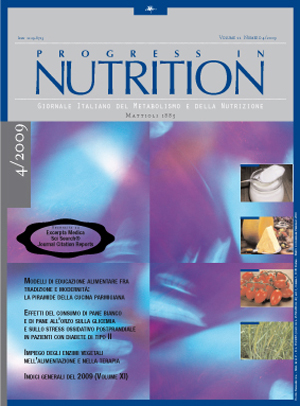Modelli di educazione alimentare fra tradizione e modernità: la piramide della cucina parmigiana
Keywords:
Diet pyramid, gastronomic traditions, Parma, Piramide alimentare, cucina tradizionaleAbstract
RiassuntoSulla base dei programmi di informazione ed educazione condotti in questi ultimi 15 anni utilizzando i diversi modelli di Piramide alimentare gli Autori, dopo aver analizzato brevemente le origini e l’evoluzione del modello originale del 1992, discutono i vantaggi e le criticità, soprattutto in termini di efficacia comunicativa, dello stesso. In particolare, partendo dai modelli culturalmente o etnicamente orientati proposti dall’Oldways Preservation and Exchange Trust fra il 1999 ed il 2004, e dalla successiva piramide della dieta toscana proposta nel 2007, gli autori descrivono un modello ancora più fortemente radicato nella cultura e nelle tradizioni gastronomiche del territorio: la piramide della cucina parmigiana. Obiettivo del modello descritto è quello di coniugare i dettami nutrizionali più aggiornati con lo stile di vita di una popolazione fortemente legata alle tradizioni gastronomiche del territorio di appartenenza.
Alimentary education programmes between tradition and modernity: the Parma diet pyramid
Summary
Based on the information and education programmes that have been conducted over the past 15 years using different diet pyramid models, the authors briefly analyse the origins and the evolution of the original 1992 model and then discuss its advantages and critical points, primarily in terms of communicative efficacy. By starting with the culturally or ethnically orientated models put forward between 1999 and 2004 by the Oldways Preservation and Exchange Trust, and by the Tuscan diet pyramid that was later proposed in 2007, the authors describe a model that is still deeply rooted in the area’s culture and gastronomic traditions: the Parma diet pyramid. The objective of this model is to merge the very latest nutritional principles with the lifestyle of people that have strong ties with the gastronomic traditions of their area.
Downloads
Published
Issue
Section
License
This is an Open Access article distributed under the terms of the Creative Commons Attribution License (https://creativecommons.org/licenses/by-nc/4.0) which permits unrestricted use, distribution, and reproduction in any medium, provided the original work is properly cited.
Transfer of Copyright and Permission to Reproduce Parts of Published Papers.
Authors retain the copyright for their published work. No formal permission will be required to reproduce parts (tables or illustrations) of published papers, provided the source is quoted appropriately and reproduction has no commercial intent. Reproductions with commercial intent will require written permission and payment of royalties.

This work is licensed under a Creative Commons Attribution-NonCommercial 4.0 International License.


